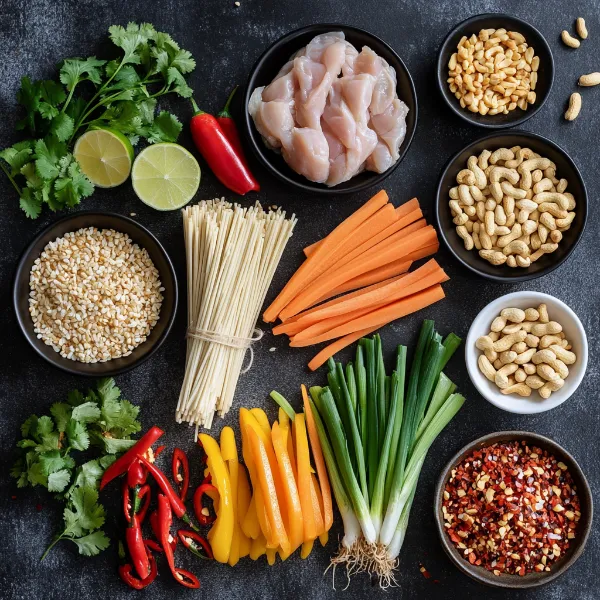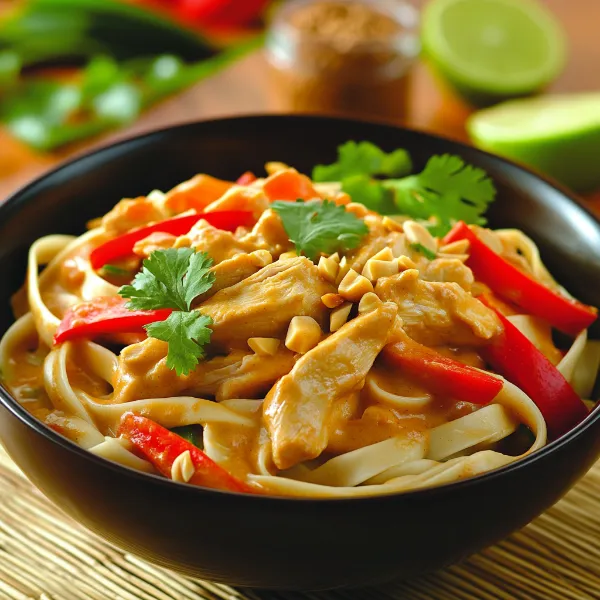Part 1: Introduction and Background
Introduction to Satay Chicken Noodles
Satay Chicken Noodles is a delightful fusion dish that combines the nutty, savoury richness of satay flavours with the satisfying texture of stir-fried noodles. A harmonious blend of tender chicken, creamy peanut sauce, and vibrant vegetables makes this dish a global favourite, offering a perfect balance of taste and texture.
This recipe takes inspiration from the traditional Southeast Asian satay, reimagining it in a noodle-based stir-fry that’s both comforting and bold in flavour.
The Origin of Satay and Its Influence
Historical Background of Satay and Peanut Sauce
Satay, a dish of marinated, grilled meat served with peanut sauce, originates from Southeast Asia, particularly Indonesia and Malaysia. The combination of aromatic spices and creamy peanut-based sauces became a staple in many regional cuisines, influencing countless modern recipes, including Satay Chicken Noodles.
How It Inspired Modern Noodle Recipes
As satay flavours gained international acclaim, chefs worldwide began incorporating its signature savory, spicy, and nutty elements into diverse dishes, leading to creative adaptations like peanut sauce-based noodles.
Popularity of Stir-Fry Dishes
Why Stir-Fried Noodles Are a Global Favourite
Stir-fried noodles are beloved for their versatility, ease of preparation, and ability to incorporate various flavours. Their adaptability allows them to feature in diverse cuisines, from Asian street food to Western kitchens.
Adaptability of the Dish to Various Cuisines
Satay Chicken Noodles exemplifies this adaptability, offering endless customisation options while maintaining its signature balance of spice and creaminess.
What Makes Satay Chicken Noodles Unique?
- The combination of savoury, spicy, and nutty flavours creates a rich and satisfying taste.
- The silky texture of peanut sauce pairs perfectly with the chewiness of stir-fried noodles and tender chicken strips.
Part 2: Ingredients and Their Roles
Key Components of the Dish
Noodles
Choosing the right noodles is essential for achieving the perfect texture. Common options include:
- Rice Noodles: Light and gluten-free, ideal for soaking up sauces.
- Egg Noodles: Chewy and rich, complementing the creamy sauce.
Chicken
Boneless cuts like chicken breast or thigh are preferred for their tenderness and ease of cooking.
The Peanut Sauce Base
Core Ingredients
The peanut sauce is the soul of this dish, crafted from:
- Peanut Butter: Creamy or crunchy for a nutty foundation.
- Soy Sauce: Adds a salty, umami depth.
- Lime Juice: Provides brightness and acidity.
- Chilli Paste: Infuses spice for a bold kick.
Optional Add-Ins
- Coconut Milk: Adds a subtle sweetness and creamy consistency.
- Fish Sauce: Deepens the flavour with a savoury edge.

Vegetables and Garnishes
Common Vegetables
- Bell Peppers: For sweetness and crunch.
- Carrots: Adds colour and a subtle sweetness.
- Spring Onions: Provides a fresh, aromatic finish.
Garnishes
- Crushed Peanuts: For texture and extra nuttiness.
- Coriander and Sesame Seeds: Add visual appeal and enhance flavour.
Seasonings and Aromatics
- Garlic, Ginger, and Onions: Serve as the aromatic base for the dish.
- Sweet, Salty, and Sour Elements: Essential for balancing flavours in the sauce.
Part 3: Cooking Techniques and Process
Preparing the Ingredients
- Thinly slice chicken for even cooking.
- Pre-cook noodles to the desired texture, ensuring they don’t overcook during stir-frying.
Making the Peanut Sauce
- Combine peanut butter, soy sauce, lime juice, and chilli paste in a bowl.
- Whisk until smooth, adjusting the consistency with water or coconut milk.
- Taste and adjust spice or sweetness as needed.
Stir-Frying the Chicken
- Marinate the chicken in soy sauce and garlic for added flavour.
- Stir-fry over high heat to achieve a golden, tender texture.
Combining Ingredients in the Wok
Add ingredients in the proper order to ensure even cooking:
- Stir-fry chicken until golden.
- Add vegetables and sauté briefly for a crunchy texture.
- Toss in noodles and pour the peanut sauce, ensuring everything is evenly coated.
Tips for Perfect Stir-Frying
- Use high heat to prevent sogginess.
- Avoid overcrowding the pan to ensure proper caramelisation.
Part 4: Variations and Adaptations
Protein Alternatives
- Tofu: A plant-based option that absorbs flavours beautifully.
- Prawns or Beef: Provide unique textures and tastes.
Vegetarian and Vegan Options
- Replace chicken with tempeh or seitan.
- Swap fish sauce for tamari or soy sauce for a vegan-friendly dish.
Gluten-Free and Low-Carb Variations
- Use rice noodles or zucchini noodles for a gluten-free or low-carb alternative.
- Substitute peanut butter with almond butter for peanut allergies.
Regional Spice Additions
- Incorporate lemongrass or kaffir lime leaves for Southeast Asian authenticity.
- Adjust spice levels to suit local preferences.

Part 5: Serving and Pairing Suggestions
How to Serve Satay Chicken Noodles
- Serve in individual bowls garnished with crushed peanuts and coriander.
- Portion sizes should be filling yet balanced for an enjoyable meal.
Side Dishes to Complement the Dish
- Cucumber Salad: A refreshing, crunchy side.
- Spring Rolls: Perfect for dipping into leftover peanut sauce.
- Asian Slaw: Adds a tangy, crisp element.
Beverage Pairings
- Iced Tea: A cooling companion to the spicy dish.
- Sparkling Water with Lime: Refreshing and light.
Storing and Reheating Leftovers
- Store noodles in an airtight container in the refrigerator.
- Reheat in a hot wok with a splash of water to restore texture and prevent drying.
Part 6: Conclusion and Final Tips
Why Satay Chicken Noodles Are a Must-Try
Satay Chicken Noodles is a versatile dish that offers bold flavours and endless customisation options. Its rich peanut sauce and stir-fried elements create a satisfying meal for any occasion.
Encouragement to Experiment
Feel free to adapt the recipe to your taste by adjusting spice levels, adding unique garnishes, or trying different proteins.
Final Cooking Tips for Success
- Prepare ingredients ahead of time for smooth stir-frying.
- Maintain balance in flavours to create the perfect dish.
Enjoy the process and savour the delicious results! Would you like detailed recipes for specific variations or tips on perfecting the peanut sauce? 😊
